A Song for the Horse Nation - Smithsonian’s National Museum of the American Indian
Washington, D.C.'s new exhibition featuring horses in Native cultures.
A new reason to make a trip to our nation's capital is the interesting and colorful exhibit “A Song for the Horse Nation” at The Smithsonian’s National Museum of the American Indian. This morning, I was treated to a preview of the exhibition, which opened October 29th and runs through January 7, 2013, and was able to meet the curator of the exhibition Emil Her Many Horses (Oglala Lakota). If you are interested in horses, history, Native American culture or all of the above, it's worth a trip. Those who enjoy viewing historic tack are in for a real treat.
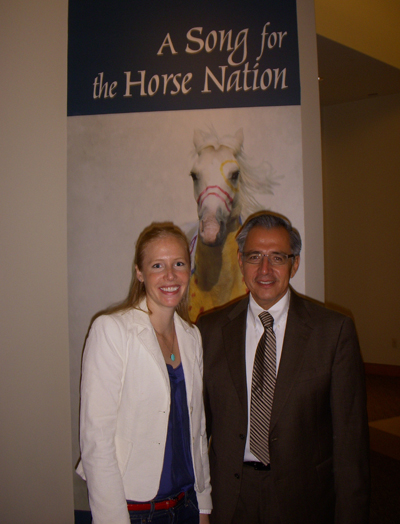
Me with Emil Her Many Horses (Oglala Lakota), curator of the exhibition at the Smithsonian's National Museum of the American Indian.
The exhibition was first shown at the museum’s George Gustav Heye Center in New York and doubles its exhibition space on the National Mall. On display are artifacts, artwork, photographs, songs and personal essays from Emil Her Many Horses and others collected over time.
Horses arrived on the scene in North America in the 1700's and would dramatically change history and the way Native cultures lived, worked, fought, thought and survived. I was able to more fully grasp these historic changes and the intense bond that humans have shared with horses throughout time, as I examined horses celebrated on everything from clothing to artwork to a 16-foot-tall, 38-foot-circumference Lakota tipi, decorated with 110 hand-painted horses.
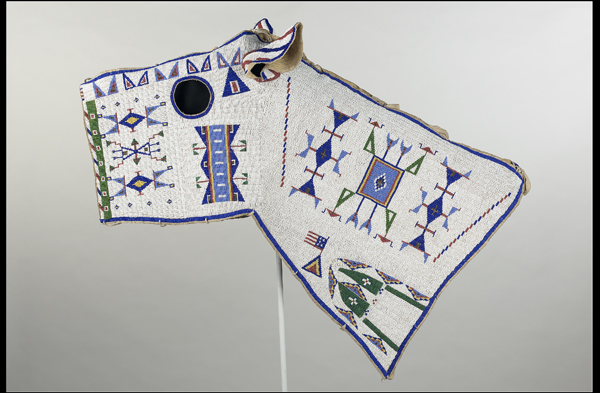
Oglala Lakota beaded horse mask, ca. 1904. Pine Ridge Reservation, South Dakota. Seed beads, hide, and sinew. National Museum of the American Indian (1413).
I was most impressed with the beaded horse designs on many of the items on display. Some of the saddles made of deer or elk antlers and wood and rawhide looked downright painful, while other elaborately beaded soft pad saddles filled with buffalo hair looked really comfortable. This is what a rider thinks about at an exhibition like this!
Many saddles were either frame saddles, made of wood and antler, or pad saddles, soft pillow-like saddles constructed from tanned hide and filled with hair or other material. These pad saddles were used by the Plains Indians during battles or for racing and hunting. I stood marveling at one common Cree style of pad saddle with its red, white and green beading. It would have been used for parades or traded for goods.
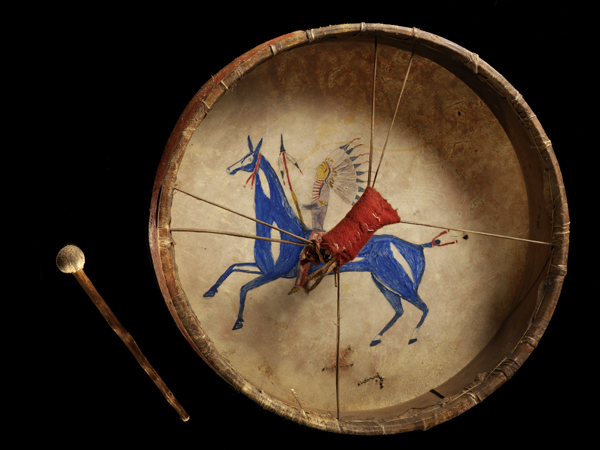
Lakota painted drum, ca. 1860s. South Dakota or North Dakota. Pigment, rawhide, wood, wool cloth, and sinew. National Museum of the American Indian (10/5940).
Native horse traditions continue today. We've been able to experience and film these in Cherokee, North Carolina, riding in the Great Smoky Mountains in the Equitrekking Carolinas episode and in Equitrekking Arizona, riding with the Navajo in Canyon de Chelly.
In the exhibition, I learned more about the Nimiipuu (Nez Perce) Young Horsemen’s Program, which seeks to preserve the Appaloosa horse breed made famous by their ancestors. There's a short video you can watch filmed with the Nez Perce and their horses.
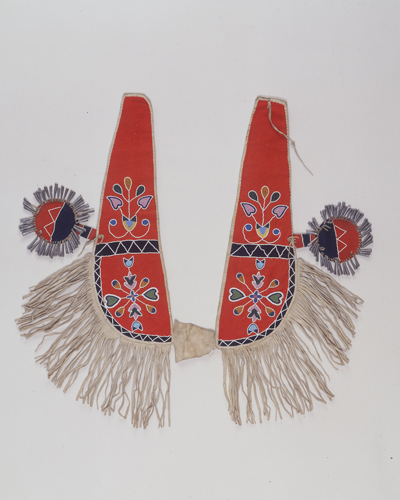
Apsáalooke (Crow) horse crupper, ca. 1885. Montana. Seed beads, wool cloth, tin cones, hide, rawhide, ribbon, and cotton thread. National Museum of the American Indian (2/3106).
One part of the exhibit that I found really interesting was a chart that showed the going rate for trading horses on early 1800's trade routes. One fine racing horse would demand ten guns. One fine hunting horse could be traded for several pack animals. To get one ordinary riding horse, you had a few options, including eight buffalo robes or fifteen eagle feathers.
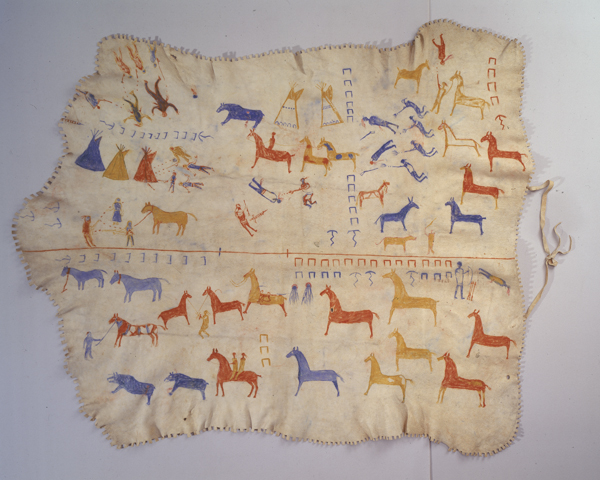
Piikuni (Blackfeet) elk-skin robe with painted decoration by Mountain Chief, mid-1800s. Montana. Pigment and hide. National Museum of the American Indian (22/1878).
“For some Native peoples, the horse still is an essential part of daily life,” said Emil Her Many Horses (Oglala Lakota), curator of the exhibition. “For others, the horse will always remain an element of our identity and our history. The Horse Nation continues to inspire, and Native artists continue to celebrate the horse in our songs, our stories and our works of art.”
How you can go: A Song for the Horse Nation website has information on the exhibit hours, dates and transportation options.
Exhibition Dates: October 29, 2011 – January 7, 2013
In honor of the opening of “A Song for the Horse Nation,” the museum is partnering with the 53rd Annual Washington International Horse Show to host a weekend of free activities and performances. Educating and engaging the nation about horses in Native American culture and equestrian sport, the museum and the Washington International Horse Show will sponsor family and children’s programming Saturday, Oct. 29, 10 a.m.-4 p.m., at the Mall museum and the Verizon Center in Washington, 10 a.m.-2 p.m., and all day Sunday, Oct. 30, 10 a.m.-4 p.m., at the museum.





